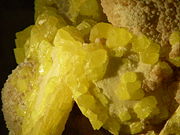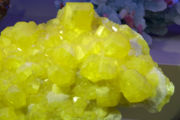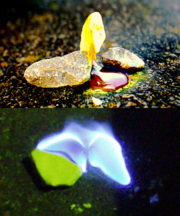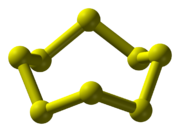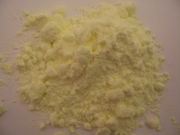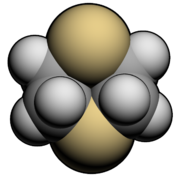Sulfur
2008/9 Schools Wikipedia Selection. Related subjects: Chemical elements
|
|||||||||||||||||||||||||||||||||||||
| General | |||||||||||||||||||||||||||||||||||||
|---|---|---|---|---|---|---|---|---|---|---|---|---|---|---|---|---|---|---|---|---|---|---|---|---|---|---|---|---|---|---|---|---|---|---|---|---|---|
| Name, symbol, number | sulfur, S, 16 | ||||||||||||||||||||||||||||||||||||
| Chemical series | nonmetals | ||||||||||||||||||||||||||||||||||||
| Group, period, block | 16, 3, p | ||||||||||||||||||||||||||||||||||||
| Appearance | Lemon yellow crystals. |
||||||||||||||||||||||||||||||||||||
| Standard atomic weight | 32.065 (5) g·mol−1 | ||||||||||||||||||||||||||||||||||||
| Electron configuration | [Ne] 3s2 3p4 | ||||||||||||||||||||||||||||||||||||
| Electrons per shell | 2, 8, 6 | ||||||||||||||||||||||||||||||||||||
| Physical properties | |||||||||||||||||||||||||||||||||||||
| Phase | solid | ||||||||||||||||||||||||||||||||||||
| Density (near r.t.) | (alpha) 2.07 g·cm−3 | ||||||||||||||||||||||||||||||||||||
| Density (near r.t.) | (beta) 1.96 g·cm−3 | ||||||||||||||||||||||||||||||||||||
| Density (near r.t.) | (gamma) 1.92 g·cm−3 | ||||||||||||||||||||||||||||||||||||
| Liquid density at m.p. | 1.819 g·cm−3 | ||||||||||||||||||||||||||||||||||||
| Melting point | 388.36 K (115.21 ° C, 239.38 ° F) |
||||||||||||||||||||||||||||||||||||
| Boiling point | 717.8 K (444.6 ° C, 832.3 ° F) |
||||||||||||||||||||||||||||||||||||
| Critical point | 1314 K, 20.7 MPa | ||||||||||||||||||||||||||||||||||||
| Heat of fusion | (mono) 1.727 kJ·mol−1 | ||||||||||||||||||||||||||||||||||||
| Heat of vaporization | (mono) 45 kJ·mol−1 | ||||||||||||||||||||||||||||||||||||
| Specific heat capacity | (25 °C) 22.75 J·mol−1·K−1 | ||||||||||||||||||||||||||||||||||||
|
|||||||||||||||||||||||||||||||||||||
| Atomic properties | |||||||||||||||||||||||||||||||||||||
| Crystal structure | orthorhombic | ||||||||||||||||||||||||||||||||||||
| Oxidation states | 6, 4, 2, 1 , -2 (strongly acidic oxide) |
||||||||||||||||||||||||||||||||||||
| Electronegativity | 2.58 (Pauling scale) | ||||||||||||||||||||||||||||||||||||
| Ionization energies ( more) |
1st: 999.6 kJ·mol−1 | ||||||||||||||||||||||||||||||||||||
| 2nd: 2252 kJ·mol−1 | |||||||||||||||||||||||||||||||||||||
| 3rd: 3357 kJ·mol−1 | |||||||||||||||||||||||||||||||||||||
| Atomic radius | 100 pm | ||||||||||||||||||||||||||||||||||||
| Atomic radius (calc.) | 88 pm | ||||||||||||||||||||||||||||||||||||
| Covalent radius | 102 pm | ||||||||||||||||||||||||||||||||||||
| Van der Waals radius | 180 pm | ||||||||||||||||||||||||||||||||||||
| Miscellaneous | |||||||||||||||||||||||||||||||||||||
| Magnetic ordering | no data | ||||||||||||||||||||||||||||||||||||
| Electrical resistivity | (20 °C) (amorphous) 2×1015Ω·m |
||||||||||||||||||||||||||||||||||||
| Thermal conductivity | (300 K) (amorphous) 0.205 W·m−1·K−1 |
||||||||||||||||||||||||||||||||||||
| Bulk modulus | 7.7 GPa | ||||||||||||||||||||||||||||||||||||
| Mohs hardness | 2.0 | ||||||||||||||||||||||||||||||||||||
| CAS registry number | 7704-34-9 | ||||||||||||||||||||||||||||||||||||
| Selected isotopes | |||||||||||||||||||||||||||||||||||||
|
|||||||||||||||||||||||||||||||||||||
| References | |||||||||||||||||||||||||||||||||||||
Sulfur or sulphur (pronounced /ˈsʌlfɚ/, see spelling below) is the chemical element that has the atomic number 16. It is denoted with the symbol S. It is an abundant multivalent non-metal. Sulfur, in its native form, is a yellow crystalline solid. In nature, it can be found as the pure element and as sulfide and sulfate minerals. It is an essential element for life and is found in two amino acids, cysteine and methionine. Its commercial uses are primarily in fertilizers, but it is also widely used in gunpowder, matches, insecticides and fungicides. Elemental sulfur crystals are commonly sought after by mineral collectors for their brightly colored polyhedron shapes. In nonscientific context it can also be referred to as brimstone.
History
Sulfur (Sanskrit, sulvari; Latin sulfur or sulpur) was known in ancient times, and is referred to in the Biblical Pentateuch ( Genesis).
English translations of the Bible commonly referred to sulfur as "brimstone", giving rise to the name of ' fire and brimstone' sermons, in which listeners are reminded of the fate of eternal damnation that awaits the unbelieving and unrepentant. It is from this part of the Bible that Hell is implied to "smell of sulfur", although as mentioned above sulfur is in fact odorless. The "smell of sulfur" usually refers to either the odour of hydrogen sulfide, e.g. from rotten egg, or of burning sulfur, which produces sulfur dioxide, the smell associated with burnt matches.
Sulfur was known in China since the 6th century BC, in a natural form that the Chinese had called 'brimstone', or shiliuhuang that was found in Hanzhong. By the 3rd century, the Chinese discovered that sulfur could be extracted from pyrite. Chinese Daoists were interested in sulfur's flammability and its reactivity with certain metals, yet its earliest practical uses were found in traditional Chinese medicine. A Song Dynasty military treatise of 1044 AD described different formulas for Chinese gun powder, which is a mixture of potassium nitrate (KNO3), carbon, and sulfur. Early alchemists gave sulfur its own alchemical symbol which was a triangle at the top of a cross.
In 1777 Antoine Lavoisier helped convince the scientific community that sulfur was an element and not a compound. In 1867, sulfur was discovered in underground deposits in Louisiana and Texas. The overlying layer of earth was quicksand, prohibiting ordinary mining operations, therefore the Frasch process was used.
Spelling and etymology
The element has traditionally been spelled sulphur in the United Kingdom, Ireland, Hong Kong, the Commonwealth Caribbean and India, but sulfur in the United States, while both spellings are used in Australia, New Zealand and Canada. IUPAC adopted the spelling “sulfur” in 1990, as did the Royal Society of Chemistry Nomenclature Committee in 1992 and the Qualifications and Curriculum Authority for England and Wales recommended its use in 2000.
In Latin, the word is variously written sulpur, sulphur, and sulfur (the Oxford Latin Dictionary lists the spellings in this order). It is an original Latin name and not a Classical Greek loan, so the ph variant does not denote the Greek letter φ. Sulfur in Greek is thion (θείον), whence comes the prefix thio-. The simplification of the Latin word's p or ph to an f appears to have taken place towards the end of the classical period, with the f spelling becoming dominant in the medieval period.
Characteristics
At room temperature, sulfur is a soft bright yellow solid. Elemental sulfur has only a faint odour, similar to that of matches. The odour associated with rotten eggs is due to hydrogen sulfide (H2S) and organic sulfur compounds rather than elemental sulfur. Sulfur burns with a blue flame that emits sulfur dioxide, notable for its peculiar suffocating odour. Sulfur is insoluble in water but soluble in carbon disulfide and to a lesser extent in other non-polar organic solvents such as benzene and toluene. Common oxidation states of sulfur include −2, +2, +4 and +6. Sulfur forms stable compounds with all elements except the noble gases. Sulfur in the solid state ordinarily exists as cyclic crown-shaped S8 molecules.
The crystallography of sulfur is complex. Depending on the specific conditions, the sulfur allotropes form several distinct crystal structures, with rhombic and monoclinic S8 best known.
A noteworthy property of sulfur is that its viscosity in its molten state, unlike most other liquids, increases above temperatures of 200 °C due to the formation of polymers. The molten sulfur assumes a dark red colour above this temperature. At higher temperatures, however, the viscosity is decreased as depolymerization occurs.
Amorphous or "plastic" sulfur can be produced through the rapid cooling of molten sulfur. X-ray crystallography studies show that the amorphous form may have a helical structure with eight atoms per turn. This form is metastable at room temperature and gradually reverts back to crystalline form. This process happens within a matter of hours to days but can be rapidly catalyzed.
Allotropes
Sulfur forms more than 30 solid allotropes, more than any other element. Besides S8, several other rings are known. Removing one atom from the crown gives S7, which is more deeply yellow than S8. HPLC analysis of "elemental sulfur" reveals an equilibrium mixture of mainly S8, but also S7 and small amounts of S6. Larger rings have been prepared, including S12 and S18. By contrast, sulfur's lighter neighbour oxygen only exists in two states of allotropic significance: O2 and O3. Selenium, the heavier analogue of sulfur can form rings but is more often found as a polymer chain.
Isotopes
Sulfur has 18 isotopes, four of which are stable: 32S (95.02%), 33S (0.75%), 34S (4.21%), and 36S (0.02%). Other than 35S, the radioactive isotopes of sulfur are all short lived. 35S is formed from cosmic ray spallation of 40argon in the atmosphere. It has a half-life of 87 days.
When sulfide minerals are precipitated, isotopic equilibration among solids and liquid may cause small differences in the δS-34 values of co-genetic minerals. The differences between minerals can be used to estimate the temperature of equilibration. The δC-13 and δS-34 of coexisting carbonates and sulfides can be used to determine the pH and oxygen fugacity of the ore-bearing fluid during ore formation.
In most forest ecosystems, sulfate is derived mostly from the atmosphere; weathering of ore minerals and evaporites also contribute some sulfur. Sulfur with a distinctive isotopic composition has been used to identify pollution sources, and enriched sulfur has been added as a tracer in hydrologic studies. Differences in the natural abundances can also be used in systems where there is sufficient variation in the 34S of ecosystem components. Rocky Mountain lakes thought to be dominated by atmospheric sources of sulfate have been found to have different δS-34 values from lakes believed to be dominated by watershed sources of sulfate.
Occurrence
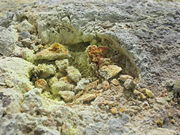
Elemental sulfur can be found near hot springs and volcanic regions in many parts of the world, especially along the Pacific Ring of Fire. Such volcanic deposits are currently mined in Indonesia, Chile, and Japan. Sicily is also famous for its sulfur mines.
Significant deposits of elemental sulfur also exist in salt domes along the coast of the Gulf of Mexico, and in evaporites in eastern Europe and western Asia. The sulfur in these deposits is believed to come from the action of anaerobic bacteria on sulfate minerals, especially gypsum, although apparently native sulfur may be produced by geological processes alone, without the aid of living organisms (see below). However, fossil-based sulfur deposits from salt domes are the basis for commercial production in the United States, Poland, Russia, Turkmenistan, and Ukraine.
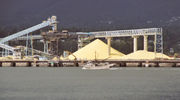
Sulfur production through hydrodesulfurization of oil, gas, and the Athabasca Oil Sands has produced a surplus - huge stockpiles of sulfur now exist throughout Alberta, Canada.
Common naturally occurring sulfur compounds include the sulfide minerals, such as pyrite (iron sulfide), cinnabar (mercury sulfide), galena (lead sulfide), sphalerite (zinc sulfide) and stibnite (antimony sulfide); and the sulfates, such as gypsum (calcium sulfate), alunite (potassium aluminium sulfate), and barite (barium sulfate). It occurs naturally in volcanic emissions, such as from hydrothermal vents, and from bacterial action on decaying sulfur-containing organic matter.
The distinctive colors of Jupiter's volcanic moon, Io, are from various forms of molten, solid and gaseous sulfur. There is also a dark area near the Lunar crater Aristarchus that may be a sulfur deposit.
Sulfur is present in many types of meteorites. Ordinary chondrites contain on average 2.1% sulfur, and carbonaceous chondrites may contain as much as 6.6%. Sulfur in meteorites is normally present entirely as troilite (FeS), but other sulfides are found in some meteorites, and carbonaceous chondrites contain free sulfur, sulfates, and possibly other sulfur compounds.
Extraction and production
Production from hydrogen sulfide
Chemically
The Claus process is used to extract elemental sulfur from hydrogen sulfide produced in hydrodesulfurization of petroleum or from natural gas.
Biologically
In the biological route, H2S from natural gas or refinery gas is absorbed with a slight alkaline solution in a wet scrubber. Or the sulfide is produced by biological sulfate reduction. In the subsequent process step, the dissolved sulfide is biologically converted to elemental sulfur. This solid sulfur is removed from the reactor. This process has been built on commercial scale. The main advantages of this process are 1) no use of expensive chemicals, 2) the process is safe as the H2S is directly absorbed in an alkaline solution, 3) no production of a polluted waste stream, 4) re-usable sulfur is produced, and 5) the process occurs under ambient conditions. The biosulfur product is different from other processes in which sulfur is produced because the sulfur is hydrophillic. Next to straightforward reuses as source for sulfuric acid production, it can also be applied as sulfur fertilizer .
Chemistry
Inorganic compounds
Hydrogen sulfide has the characteristic smell of rotten eggs. Dissolved in water, hydrogen sulfide is acidic and will react with metals to form a series of metal sulfides. Natural metal sulfides are common, especially those of iron. Iron sulfide is called pyrite, the so-called fool's gold. Pyrite can show semiconductor properties. Galena, a naturally occurring lead sulfide, was the first semiconductor discovered, and found a use as a signal rectifier in the "cat's whiskers" of early crystal radios.
Many of the unpleasant odours of organic matter are based on sulfur-containing compounds such as methyl and ethyl mercaptan, also used to scent natural gas so that leaks are easily detectable. The odour of garlic and " skunk stink" are also caused by sulfur-containing organic compounds. Not all organic sulfur compounds smell unpleasant; for example, grapefruit mercaptan, a sulfur-containing monoterpenoid is responsible for the characteristic scent of grapefruit.
Polymeric sulfur nitride has metallic properties even though it does not contain any metal atoms. This compound also has unusual electrical and optical properties. This polymer can be made from tetrasulfur tetranitride S4N4.
Phosphorus sulfides are useful in synthesis. For example, P4S10 and its derivatives Lawesson's reagent and naphthalen-1,8-diyl 1,3,2,4-dithiadiphosphetane 2,4-disulfide are used to replace oxygen from some organic molecules with sulfur.
- Sulfides (S2−), a complex family of compounds usually derived from S2−. Cadmium sulfide (CdS) is an example.
- Sulfites (SO32−), the salts of sulfurous acid (H2SO3) which is generated by dissolving SO2 in water. Sulfurous acid and the corresponding sulfites are fairly strong reducing agents. Other compounds derived from SO2 include the pyrosulfite or metabisulfite ion (S2O52−).
- Sulfates (SO42−), the salts of sulfuric acid. Sulfuric acid also reacts with SO3 in equimolar ratios to form pyrosulfuric acid (H2S2O7).
- Thiosulfates(S2O32−).Sometimes referred as thiosulfites or "hyposulfites", Thiosulfates are used in photographic fixing (HYPO) as reducing agents. Ammonium thiosulfate is being investigated as a cyanide replacement in leaching gold.
- Sodium dithionite, Na2S2O4, is the highly reducing dianion derived from hyposulfurous/dithionous acid.
- Sodium dithionate (Na2S2O6).
- Polythionic acids (H2SnO6), where n can range from 3 to 80.
- Peroxymonosulfuric acid (H2SO5) and peroxydisulfuric acids (H2S2O8), made from the action of SO3 on concentrated H2O2, and H2SO4 on concentrated H2O2 respectively.
- Sodium polysulfides (Na2Sx)
- Sulfur hexafluoride, SF6, a dense gas at ambient conditions, is used as nonreactive and nontoxic propellant
- Sulfur nitrides are chain and cyclic compounds containing only S and N. Tetrasulfur tetranitride S4N4 is an example.
- Thiocyanates contain the SCN− group. Oxidation of thiocyanoate gives thiocyanogen, (SCN)2 with the connectivity NCS-SCN.
Organic compounds
(R, R', and R are organic groups such as CH3):
- Thioethers have the form R-S-R′. These compounds are the sulfur equivalents of ethers.
- Sulfonium ions have the formula RR'S-'R'", i.e. where three groups are attached to the cationic sulfur centre. Dimethylsulfoniopropionate (DMSP; (CH3)2S+CH2CH2COO−) is a sulfonium ion, which is important in the marine organic sulfur cycle.
- Thiols (also known as mercaptans) have the form R-SH. These are the sulfur equivalents of alcohols.
- Thiolates ions have the form R-S-. Such anions arise upon treatment of thiols with base.
- Sulfoxides have the form R-S(=O)-R′. A common sulfoxide is DMSO.
- Sulfones have the form R-S(=O)2-R′. A common sulfone is sulfolane C4H8SO2.
Applications
One of the direct uses of sulfur is in vulcanization of rubber, where polysulfides crosslink organic polymers. Sulfur is a component of gunpowder. It reacts directly with methane to give carbon disulfide, which is used to manufacture cellophane and rayon.
Elemental sulfur is mainly used as a precursor to other chemicals. Approximately 85% (1989) is converted to sulfuric acid (H2SO4), which is of such prime importance to the world's economies that the production and consumption of sulfuric acid is an indicator of a nation's industrial development. . For example, more sulfuric acid is produced in the United States every year than any other industrial chemical. The principal use for the acid is the extraction of phosphate ores for the production of fertilizer manufacturing. Other applications of sulfuric acid include oil refining, wastewater processing, and mineral extraction.
Sulfur compounds are also used in detergents, fungicides, dyestuffs, and agrichemicals. In silver-based photography sodium and ammonium thiosulfate are used as "fixing agents."
An increasing application is as fertilizer. Standard sulfur is hydrophobic and therefore has to be covered with a surfactant by bacteria in the ground before it can be oxidized to sulfate. This makes it a slow release fertilizer, which cannot be taken up by the plants instantly, but has to be oxidized to sulfate over the growth season. Bioogically produced sulfur particles are naturally hydrphillic due to a biopolymer coating. This sulfur is therefore easier the disperse over the land (via spraying as a diluted slurry), and results in a faster release.
Sulfites, derived from burning sulfur, are heavily used to bleach paper. They are also used as preservatives in dried fruit.
Magnesium sulfate, better known as Epsom salts, can be used as a laxative, a bath additive, an exfoliant, a magnesium supplement for plants, or a desiccant.
Specialized applications
Sulfur is used as a light-generating medium in the rare lighting fixtures known as sulfur lamps.
Historical applications
In the late 18th century, furniture makers used molten sulfur to produce decorative inlays in their craft. Because of the sulfur dioxide produced during the process of melting sulfur, the craft of sulfur inlays was soon abandoned. Molten sulfur is sometimes still used for setting steel bolts into drilled concrete holes where high shock resistance is desired for floor-mounted equipment attachment points. Pure powdered sulfur was also used as a medicinal tonic and laxative.
Fungicide
Sulfur is the only fungicide in organic apple production against the main disease apple scab under colder conditions. Sulfur is also a major fungicide in conventional culture of grapes, strawberry, many vegetables and several other crops. It has a good efficacy against a wide range of powdery mildew diseases. Sulfur is one of the oldest pesticides used in agriculture. In organic production sulfur is the most important fungicide used. Biosulfur (biologically produced elemental sulfur with hydrophillic characteristics) can be used well for these applications.
Biological role
See sulfur cycle for more on the inorganic and organic natural transformations of sulfur.
Sulfur is an essential component of all living cells.
Inorganic sulfur forms a part of iron-sulfur clusters, and sulfur is the bridging ligand in the CuA site of cytochrome c oxidase, a basic substance involved in utilization of oxygen by all aerobic life.
Sulfur may also serve as chemical food source for some primitive organisms: some forms of bacteria use hydrogen sulfide (H2S) in the place of water as the electron donor in a primitive photosynthesis-like process in which oxygen is the electron receptor. The photosynthetic green and purple sulfur bacteria and some chemolithotrophs use elemental oxygen to carry out such oxidization of hydrogen sulfide to produce elemental sulfur (So), oxidation state = 0. Primitive bacteria which live around deep ocean volcanic vents oxidize hydrogen sulfide in this way with oxygen: see giant tube worm for an example of large organisms (via bacteria) making metabolic use of hydrogen sulfide as food to be oxidized.
The so-called sulfur bacteria, by contrast, "breathe sulfate" instead of oxygen. They use sulfur as the electron acceptor, and reduce various oxidized sulfur compounds back into sulfide-- often into hydrogen sulfide. They also can grow on a number of other partially oxidized sulfur compounds (e. g. thiosulfate, thionates, polysulfides, sulfite). These bacteria are responsible for the rotten egg smell of some intestinal gases and decomposition products.
Sulfur is a part of many bacterial defense molecules. For example, though sulfur is not a part of the lactam ring, it is a part of most beta lactam antibiotics, including the penicillins, cephalosporins, and monobactams.
Sulfur is absorbed by plants via the roots from soil as the sulfate ion and reduced to sulfide before it is incorporated into cysteine and other organic sulfur compounds (see sulfur assimilation for details of this process).
Sulfur is regarded as secondary nutrient although plant requirements for sulfur are equal to and sometimes exceed those for phosphorus. However sulfur is recognized as one of the major nutrients essential for plant growth, root nodule formation of legumes and plants protection mechanisms. Sulfur deficiency has become widespread in many countries in Europe. Because atmospheric inputs of sulfur will continue to decrease, the deficit in the sulfur input/output is likely to increase, unless sulfur fertilizers are used.
In plants and animals the amino acids cysteine and methionine contain sulfur, as do all polypeptides, proteins, and enzymes which contain these amino acids. Homocysteine and taurine are other sulfur-containing acids which are similar in structure, but which are not coded for by DNA, and are not part of the primary structure of proteins. Glutathione is an important sulfur-containing tripeptide which plays a role in cells as a source of chemical reduction potential in the cell, through its sulfhydryl (-SH) moiety. Many important cellular enzymes use prosthetic groups ending with -SH moieties to handle reactions involving acyl-containing biochemicals: two common examples from basic metabolism are coenzyme A and alpha-lipoic acid.
Disulfide bonds (S-S bonds) formed between cysteine residues in peptide chains are very important in protein assembly and structure. These strong covalent bonds between peptide chains give proteins a great deal of extra toughness and resiliency. For example, the high strength of feathers and hair is in part due to their high content of S-S bonds and their high content of cysteine and sulfur (eggs are high in sulfur because large amounts of the element are necessary for feather formation). The high disulfide content of hair and feathers contributes to their indigestibility, and also their odour when burned.
Traditional medical role for elemental sulfur
In traditional medical skin treatment which predates modern era of scientific medicine, elemental sulfur has been used mainly as part of creams to alleviate various conditions such as psoriasis, eczema and acne. The mechanism of action is not known, although elemental sulfur does oxidize slowly to sulfurous acid, which in turn (though the action of sulfite) acts as a mild reducing and antibacterial agent.
Precautions
Carbon disulfide, carbon oxysulfide, hydrogen sulfide, and sulfur dioxide should all be handled with care.
Although sulfur dioxide is sufficiently safe to be used as a food additive in small amounts, at high concentrations it reacts with moisture to form sulfurous acid which in sufficient quantities may harm the lungs, eyes or other tissues. In organisms without lungs such as insects or plants, it otherwise prevents respiration.
Hydrogen sulfide is toxic. Although very pungent at first, it quickly deadens the sense of smell, so potential victims may be unaware of its presence until death or other symptoms occur.
Environmental impact
The burning of coal and/or petroleum by industry and power plants generates sulfur dioxide (SO2), which reacts with atmospheric water and oxygen to produce sulfuric acid (H2SO4). This sulfuric acid is a component of acid rain, which lowers the pH of soil and freshwater bodies, sometimes resulting in substantial damage to the natural environment and chemical weathering of statues and structures. Fuel standards increasingly require sulfur to be extracted from fossil fuels to prevent the formation of acid rain. This extracted sulfur is then refined and represents a large portion of sulfur production. In coal fired power plants, the flue gases are sometimes purified. In more modern power plants that use syngas the sulfur is extracted before the gas is burned.

